How to invest in banks? [Guide]
The bank is one of the key institutions in the capitalist economy. Thanks to the available capital, banks can finance investment and consumption projects. In today's text, the reader will find answers to the following questions:
- What is a fractional reserve system?
- What are the most popular types of banks?
- How to invest in banks on the stock exchange?
The beginnings of banking
The very concept of the bank is very old. The first banking activities were born in antiquity. Back then, Babylonian merchants offered loans against grain. In ancient Greece and Rome, offers for collecting deposits and currency exchange began to appear. Still, these initial concepts lacked the scale to work in many cities or countries. Temples, which accumulated huge treasures, which they often borrowed "at interest", played a large role in the financial system.
The first "modern" banks appeared at the end of the Middle Ages and the beginning of the Renaissance. It was then that in rich, merchant cities, rich families appeared, who, thanks to their estates, were able to grant loans to both merchants and royal families. At the same time, they built numerous branches that dealt with transfers of funds, collecting deposits, granting loans and exchanging currencies. Families were an example of such activities Bardich i Peruzzis in Florence. Bank Peruzzich had 15 representative offices - from London to the Middle East. Thanks to this, he was able to finance trade with the countries of the Levant, which was very profitable before the era of geographical discovery. At the beginning of the XNUMXth century, the first city banks appeared. One example is St. George founded in 1407 by the city of Genoa. The oldest bank in the world that operated until the present day was Monte dei Paschi di Siena, which was founded in 1472.
Fractional reserve system
The concept developed in the following years fractional reserve system. It means that banks borrow money deposited by their clients. They only keep a small percentage of their funds in reserve in case a depositor has to settle a withdrawal. Such a system reduces interest rates on loans, however, makes the financial system more vulnerable to destabilization by means of "Run on the bank". A bank run is when a significant number of depositors wish to withdraw money at the same time. There are many more requests for payouts than you have reserves. The bank must then suspend withdrawals of funds. The news of one bank's problems causes people to panic withdrawing money from other banks. The situation is most often saved by the central bank, which as the "lender of last resort" injects liquidity into the banking sector.
Banks' activities and regulations
The core business of most banks has not changed for decades. It still consists of collecting deposits and granting investment and consumer loans. Of course, the method of obtaining funds, risk control and ways of satisfying customer needs have evolved over the years. An example is the trend of online banking. Thanks to this solution, from the application level, an individual customer can perform most of the activities that are possible in a bank branch.
After 2008, the banks faced criticism. Journalists, politicians and ordinary citizens blamed the banks for greed, which they believe led to the subprime crisis. In such an atmosphere, new regulations were introduced to prevent a repeat of 2008. The increase in regulation and the environment of low interest rates caused it to decline ROE (return on equity). The increase in regulation meant that banks began to lose competition with many technology companies (Fintech). Nevertheless, banks are still one of the most important components of the global economy. Nowadays, without banks, the allocation of capital in the economy would be much less effective.
Types of banks
Retail banks
These are banks that provide services related to the granting of loans and credits to both individual clients and enterprises. As a rule, these types of banks do not speculate on the stock, bond or derivative markets. Sometimes retail banks evolve into universal banks that deal with both retail and investment banking.
Retail banks generate two main types of income:
- Interest
- Commission
Interest income comes from loans granted on interest. The higher the interest rates, the higher the interest income. This is due to the fact that a significant part of the loans are based on a variable interest rate. The increase in the interest rate causes the interest on loans granted with a variable interest rate to increase.
Commission income includes, among others fees for transfers or account maintenance. In addition, as the name suggests, this income item includes commissions for, for example, granting a loan or a loan.
Investment banks
These are banks that date back to the XNUMXth century. Such institutions are not concerned with encouraging retail customers to deposit. Investment banks focus on offering wealth management services, brokerage services or participate in mergers and acquisitions. In addition, they invest funds in financial instruments or sometimes create them themselves. The most famous investment banks include: Goldman Sachs, JP Morgan or nonexistent already Lehman Brothers. This type of activity is much more difficult to value for a fundamental analyst. This is due to the fact that in the case of some banks, a large part of the financial result depends on the profitability of the department dealing with investing and speculating on the capital or currency markets.
Investment banks are a very important institution on the capital market. In the United States during application Glass – Steagall Act (enacted in 1933) the activities of investment and commercial banks were separated. Banks that collected customer deposits could not be investment banks at the same time. However, in 1999, there was deregulation, which caused many "traditional" banks to extend their offer to investment banking.
Central banks
These are most often state-owned banks, however, in their history, it happened that they were institutions that allowed private capital. This has been the case for many years with Bank of England, or the Bank of Poland (it operated in the Second Republic of Poland, currently it plays its role National Bank of Poland). The task of central banks is to maintain price stability (striving to achieve the inflation target) and, in the case of some banks, there are additional goals, such as: supporting full employment or caring for economic growth in the country. To achieve its goals, the central bank changes interest rates, uses open market operations and sometimes uses non-standard measures (e.g. quantitative easing).
How to invest in Banks?
In the overwhelming majority of cases, an individual investor is not able to establish a bank. This is due to capital requirements and the creation of an appropriate scale for the bank to compete with the largest players. However, you don't need to build a brewery to drink beer. An investor can take advantage of the capital market to gain exposure to this sector of the economy. The simplest solutions are:
- Acquisition of bank shares
- Buying ETFs with exposure to the banking market
- Use of derivatives on bank indices or individual banks
Purchase of bank shares
This is one of the most difficult ways to gain exposure to the banking sector. The investor has to choose which of the available banks will perform best from a given basket. The choice may apply to both the "long only" and long-short strategies (taking a long position on one bank and taking a short position on the shares of another bank). There are many banks listed on the stock exchange. An investor can buy shares of universal and investment banks as well as… of the central bank.
Swiss National Bank
It is the central bank of Switzerland. It was founded in 1907. The owners of the shares are cantons and private investors. Despite the fact that the SNB has achieved stunning profits more than once, it could only pay out a dividend of 6% of the share capital (currently 15 Swiss francs per share). The remainder of the profits are distributed to the cantons and the Swiss government. The investment is only possible for investors with rich portfolios. One share costs over CHF 6500.
| CHF million | 2019 | 2020 | 2021 |
| revenues | 49 268 | 21 257 | 26 666 |
| net profit | 48 851 | 20 869 | 26 300 |
Source: own study
Goldman Sachs
It is an American investment bank that additionally provides numerous financial services. The company was founded in 1869 and is based in Lower Manhattan on Wall Street. Goldman Sachs also has branches in such cities as London, Hong Kong, Tokyo, Salt Lake City, Warsaw and Bangalore. The bank is a very important player on the US capital market and foreign markets. It is also one of the largest companies in the world as it ranks 6th in the Fortune 500 list. Goldman Sach has been designated by the American Financial Stability Board as SIFI (Systemically Important Financial Institution). Goldman Sachs has often been described (along with other investment banks) as "complicit" in the subprime crisis in 2007–2009. On the other hand, Goldman Sachs has been financing, arranging financing or assisting in the IPO of many startups for many years. Examples include companies such as Bumble, Twitter and Robinhood.
| $ million | 2018 | 2019 | 2020 | 2021 |
| revenues | 33 256 | 33 274 | 44 559 | 59 339 |
| net profit | 9 860 | 7 897 | 8 915 | 21 151 |
Source: own study
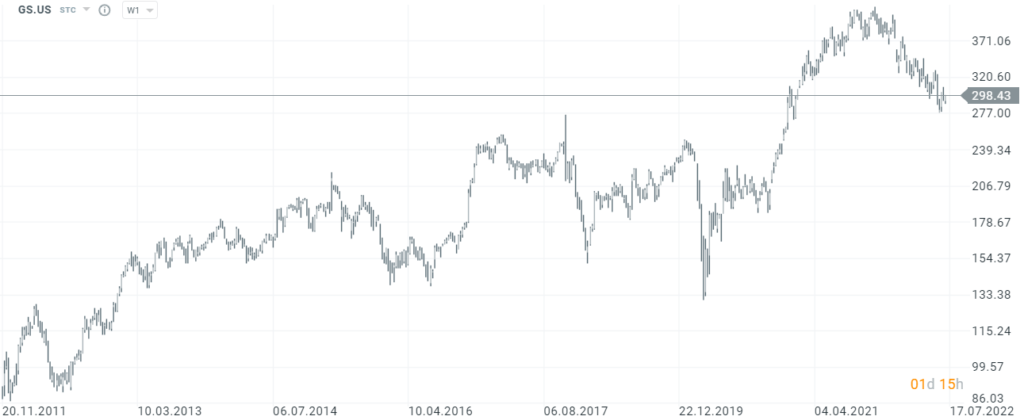
Goldman Sachs chart, interval W1. Source: xNUMX XTB.
JP Morgan Chase
The origins of the bank date back to 1799 when The Bank of the Manhattan Company was established. Others consider the founding of JP Morgan & Co. in 1871. The bank took an active part in saving the American financial system by taking over Bear Stearns and Washington Mutual in 2008. At the end of Q2022 2021, it was the largest bank in the United States. As with Goldman, JP Morgan is known for his investment banking. Due to the fact that it also has side activities, it is considered a universal bank. It has the largest share in the US retail market (in terms of the size of deposits) and is the largest issuer of payment cards in the US. It is also the largest investment bank in the world (in terms of generated commissions). At the end of 3, JP Morgan Chase had over $ 100 billion in assets under management. The entire bank generates 76% of its revenues from North America (mainly the USA).
| $ million | 2018 | 2019 | 2020 | 2021 |
| revenues | 109 029 | 115 627 | 119 475 | 121 685 |
| net profit | 30 709 | 34 642 | 27 410 | 46 503 |
Source: own study
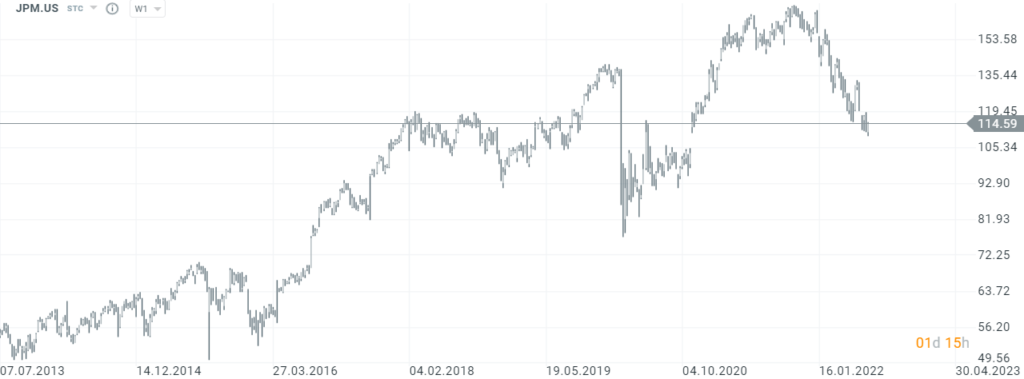
JP Morgan chart, interval W1. Source: xNUMX XTB.
Deutsche Bank
The origins of the bank date back to 1870, when a bank was established to support foreign investments and German exports. It is a universal bank with headquarters in Germany. It is Germany's largest financial institution and component DAX index. The bank currently employs over 80 people. It is worth noting that even twenty years ago it was one of the 000 largest banks in the world. In 10, Deutsche Bank was the 1999th largest asset management company. After the 4-2007 crisis, the bank is unable to return to the path of growth. Over the past 2009 years, Deutsche Bank's share price has fallen by more than 10%. The bank's activities focus on such areas as: investment banking, asset management, retail banking, corporate banking and private banking. A few years ago, the bank's difficult situation resulted in rumors about the planned merger of the two largest banks in Germany (Deutsche Bank and Commerzbank). Currently, plans to merge the two banks are set aside.
| million € | 2018 | 2019 | 2020 | 2021 |
| revenues | 25 095 | 22 950 | 23 793 | 25 313 |
| net profit | -25 | -5 719 | 146 | 2 002 |
Source: own study
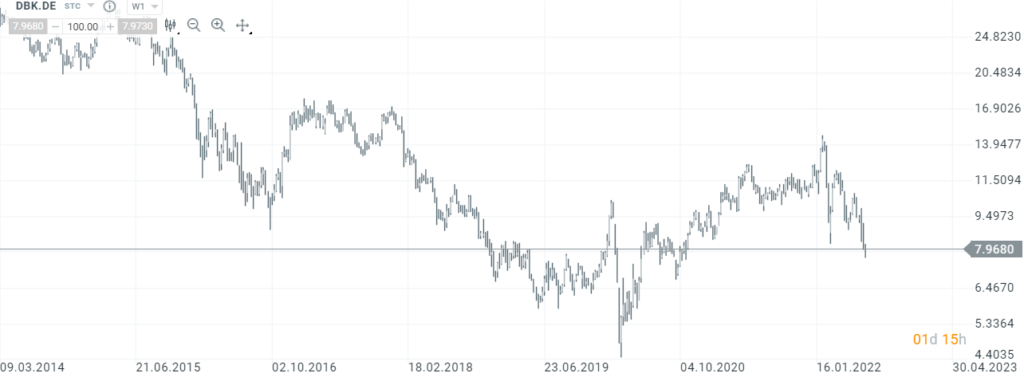
Deutsche Bank chart, interval W1. Source: xNUMX XTB.
PKO Bank Polski
The history of the bank dates back to 1919, when the Pocztowa Kasa Oszczędności was established by the decree of Józef Piłsudski. For a short period of its history, the bank operated as part of the National Bank of Poland (1975 - 1987). Then it became an independent unit again. PKO BP is the largest universal bank in Poland. PKO BP is the largest bank in Poland in terms of deposits. In 2021, the bank's assets exceeded PLN 400 billion, while the number of customers exceeded 11 million. It is worth mentioning that in 2021 alone, the bank granted credits and loans worth less than PLN 250 billion. The bank focuses on the development of mobile banking. The IKO application is already used by 6,1 million customers. The minority shareholder is the Polish state treasury. The bank operates both private, corporate and investment banking. The bank also has its own Towarzystwo Funduszy Inwestycyjnych and brokerage activities.
| PLN million | 2018 | 2019 | 2020 | 2021 |
| revenues | 13 526 | 14 775 | 14 586 | 15 148 |
| net profit | 3 741 | 4 031 | -2 557 | 4 874 |
Source: own study
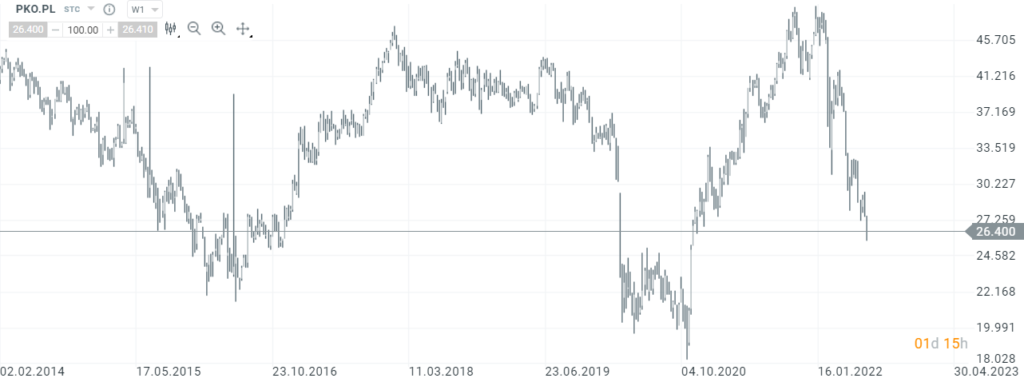
PKO BP chart, interval W1. Source: xNUMX XTB.
BNP Paribas
It is one of the largest European banks. It is one of the components of the CAC 40 index. The bank was created as a result of the merger of BNP (Banque Nationale de Paris) and Paribas (Banque de Paris et des Pays-Bas). The mentioned merger took place in 2000. It is a universal bank, it has both stationary and online banking. Both individual clients and enterprises can use the bank's services. BNP Paribas also has extensive asset management and brokerage services. It generates the largest part of its revenues in Europe. The American and Asian markets are next. The bank separates three segments: Commercial & Personal Banking (55% of revenues), Investments & Protection Services (14%) and Corporate & Investment Banking (31%). In 2021, the bank employed over 190 employees, of which over 000 work for C&P Banking. The bank is listed, among others on the Euronext exchange and the Warsaw Stock Exchange.
| million € | 2018 | 2019 | 2020 | 2021 |
| revenues | 51 994 | 55 005 | 54 779 | 56 355 |
| net profit | 7 159 | 7 745 | 6 626 | 9 052 |
Source: own study
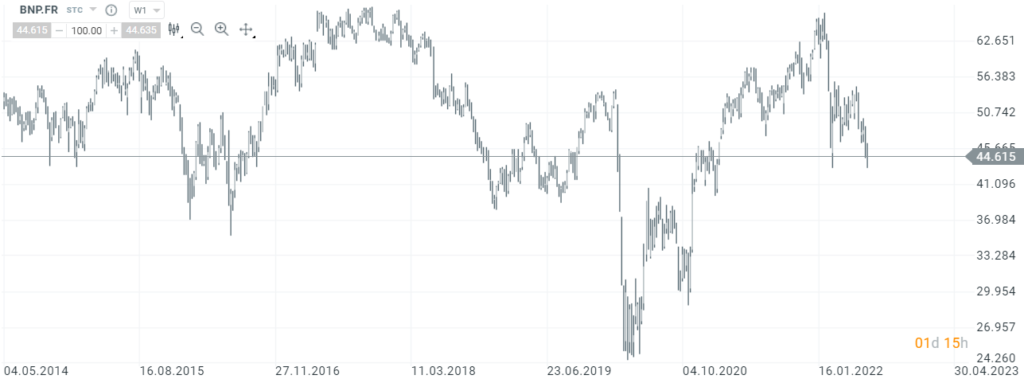
BNP Paribas chart, interval W1. Source: xNUMX XTB.
Industrial and Commercial Bank of China
It is one of the largest banks in the world. According to The Top 1000 World Banks ranking prepared by The Bankers, ICBC was classified in the first place. The bank was founded in 1984 as a state-owned bank. After the restructuring of the company, the bank made its debut on the Hong Kong and Shanghai stock exchanges in 2006. Despite its debut on the stock exchange, it is still a state institution, as 70% of the shares are owned by the Chinese government through its investment vehicles or agencies. Due to its operation in China, the scale of this bank's operation is difficult to imagine for a typical European bank. In 2021, ICBC had over 9,6 million corporate clients and over 700 million retail clients. The bank has a network of over 15 branches and over 700 ATMs.
| CNY million | 2018 | 2019 | 2020 | 2021 |
| revenues | 770 700 | 852 644 | 881 361 | 939 893 |
| net profit | 297 676 | 312 224 | 315 906 | 348 338 |
Source: own study
Investing in ETFs
ETFs are the easiest way to invest in the banking sector. Thanks to this financial instrument, it is possible to buy a basket of bank shares at low cost. By paying one commission, the investor has exposure to the stocks of dozens of banks. If an investor wanted to build a similar composition of the portfolio himself, he would pay a much higher commission and would need a much larger capital. Another advantage of ETFs is their low management costs, which are lower than those charged in actively managed funds. Below, we briefly characterize selected ETFs with exposure to the banking market:
MSCI World Financials UCITS ETF
Established in 2016 and has so far raised £ 427m under management. The ETF follows the MSCI World Financials Index. Thus, by investing in this ETF, the buyer obtains exposure to the market of large and medium-sized developed markets companies operating in the financial sector. The composition of the ETF is updated quarterly. Slightly more than half of the assets (51%) are invested in American companies. Canadian companies (10%) and the United Kingdom (6%) are next. The annual fund management fee is 0,25%. Among the top 5 components of the index are:
- Berkshire Hathaway
- JP Morgan Chase
- Bank of America
- Wells Fargo
- Royal Bank of Canada
Invesco KBW Bank ETF (KBWB)
It is an ETF with over approximately $ 5 billion in assets under management as of July 2022, 1,7. This instrument mimics the performance of the KBW Nasdaq Bank index. By investing in the ETF, the buyer gets exposure to the US banking sector. It is dominated by large companies, which are responsible for 94% of assets under management. The annual fund management fee is 0,35%. Among the top 5 components of the index are:
- Wells Fargo
- US Bancorp
- Citigroup
- JP Morgan Chase
- Bank of America
Derivatives with exposure to the banking sector
This is a solution for those who prefer using leverage in their investments. There are many futures on "banking" indices. An example is EURO STOXX® Banks Futures (FESB). It is a very liquid financial instrument. At the end of July 6, 2022, the FESB futures with September execution had over 1,8 million open contracts. The contract multiplier is € 50 per 1 point. As a result, the notional value of one contract was around € 7 on July 2022, 3900. The index gives exposure to the largest banks in the European Union that are listed on stock exchanges.
Forex brokers offering ETFs and stocks
How to invest in banks? Of course, the simplest option is to buy only shares, but for people who want to well diversify and balance their portfolio, investing in dividend companies through entire ETFs will be a better choice. An increasing number of forex brokers have quite a rich offer of stocks, ETFs and CFDs for these instruments.
For example on XTB Today, we can find over 3500 equity instruments and 400 ETFs, a Saxo Bank over 19 companies and 000 ETF funds.
| Broker |  |
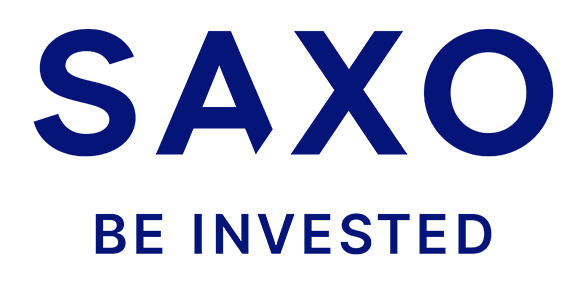 |
 |
| End | Poland | Denmark | Cyprus * |
| Number of exchanges on offer | 16 exchanges | 37 exchanges | 24 exchanges |
| Number of shares in the offer | approx. 3500 - shares circa 2000 - CFDs on shares |
19 - shares 8 - CFDs on shares |
approx. 3 - CFD on shares |
| The amount of ETF on offer | approx. 400 - ETF approx. 170 - CFD on ETF |
3000 - ETF 675 - CFD on ETF |
approx. 100 - CFD on ETF |
| Commission | 0% commission up to EUR 100 turnover / month | according to the price list | Spread depends on the instrument |
| Min. Deposit | PLN 0 (recommended min. PLN 2000 or USD 500, EUR) |
0 PLN / 0 EUR / 0 USD | PLN 500 |
| Platform | xStation | SaxoTrader Pro Saxo Trader Go |
Plus500 platform |
* PLUS500 CY offer
CFDs are complex instruments and come with a high risk of losing money rapidly due to leverage. From 72% to 89% of retail investor accounts record monetary losses as a result of trading CFDs. Think about whether you understand how CFDs work and whether you can afford the high risk of losing your money.
How to measure bank efficiency
If the investor intends to select companies for the portfolio himself, he must apply the criteria for selecting companies. An example might be:
- ROE
- ROA
- Net interest margin
- NPL
ROE is return on equity. This indicator allows you to determine how much profit the bank generates from its equity capital. The higher the ratio, the theoretically better the operational efficiency of the bank. The exception is when high ROE results from unnaturally low equity. This may mean that the bank does not have sufficient capital to cope with the poorer macroeconomic conditions.
ROA it is the profitability of the assets held. The ratio is calculated by dividing the net profit by the total assets. The higher the ROA, the better the bank's asset management. As a result, such a bank has a chance to develop faster than the competition.
Net interest margin (NIM) it is the difference between the earnings generated from the loans granted and the costs of obtaining capital (e.g. interest on deposits). NIM tends to follow interest rates. The higher the market interest rates, the NIM should rise. This is because the interest rate on loans reacts faster to an increase in interest rates than the interest rate on deposits.
NPL it's different “Non performing loans”. It is an indicator that informs about the number of loans granted with delays in repayment exceeding 90 days. As a rule, the safe level of NPL is considered to be around 2%.
Watch out for fintechs
Although banks had a dominant position on the financial market for decades (with almost no alternatives), a formidable competition has emerged in recent years - fintechs. Fintech is a company operating on the financial market, which very often has services that partly coincide with the bank's offer. This results in "nibbling" on the banking segment. Examples include companies collecting and borrowing money, providing no-cost brokerage services or offering the BNPL (Buy now, pay later) service. Of course, banks are responding to this competition by developing online banking services to attract younger customers.






















![Forex Club – Tax 9 – Settle tax on a foreign broker [Download the Application] Forex Club - Tax 9](https://forexclub.pl/wp-content/uploads/2024/02/Forex-Club-Podatek-9-184x120.jpg?v=1709046278)
![Trading View platform – solutions tailored to the needs of traders [Review] trading view review](https://forexclub.pl/wp-content/uploads/2024/03/trading-view-recenzja-184x120.jpg?v=1709558918)
![How to connect your FP Markets account to the Trading View platform [Guide] fp markets trading view](https://forexclub.pl/wp-content/uploads/2024/02/fp-markets-trading-view-184x120.jpg?v=1708677291)
![How to invest in ChatGPT and AI? Stocks and ETFs [Guide] how to invest in chatgpt and artificial intelligence](https://forexclub.pl/wp-content/uploads/2023/02/jak-inwestowac-w-chatgpt-i-sztuczna-inteligencje-184x120.jpg?v=1676364263)


![WeWork – the anatomy of the collapse of a company valued at $47 billion [WeWork, part II] wework bankruptcy story](https://forexclub.pl/wp-content/uploads/2024/04/wework-bankructwo-historia-184x120.jpg?v=1711729561)
![Adam Neumann – the man who screwed up Softbank [WeWork, part AND] adam neumann wework](https://forexclub.pl/wp-content/uploads/2024/04/adam-neumann-wework-184x120.jpg?v=1711728724)





![How to transfer shares to another brokerage office [Procedure description] how to transfer shares to another brokerage house](https://forexclub.pl/wp-content/uploads/2024/03/jak-przeniesc-akcje-do-innego-biura-maklerskiego-184x120.jpg?v=1709556924)

![The most common mistakes of a beginner trader - Mr Yogi [VIDEO] Scalping - The most common mistakes of a beginner trader - VIDEO](https://forexclub.pl/wp-content/uploads/2024/03/Scalping-Najczestsze-bledy-poczatkujacego-tradera-VIDEO-184x120.jpg?v=1711601376)
![Learning patience: No position is also a position - Mr Yogi [VIDEO] Scalping - Learning patience - No position is also a position - VIDEO](https://forexclub.pl/wp-content/uploads/2024/03/Scalping-Nauka-cierpliwosci-Brak-pozycji-to-tez-pozycja-VIDEO-184x120.jpg?v=1710999249)
![When to exit a position and how to minimize losses - Mr Yogi [VIDEO] Scalping - When to exit a position and how to minimize losses - VIDEO](https://forexclub.pl/wp-content/uploads/2024/03/Scalping-Kiedy-wyjsc-z-pozycji-i-jak-minimalizowac-straty-VIDEO-184x120.jpg?v=1710336731)


![How to invest in banks? [Guide] how to invest in banks](https://forexclub.pl/wp-content/uploads/2022/07/jak-inwestowac-w-banki.jpg?v=1657269612)
![How to invest in ChatGPT and AI? Stocks and ETFs [Guide] how to invest in chatgpt and artificial intelligence](https://forexclub.pl/wp-content/uploads/2023/02/jak-inwestowac-w-chatgpt-i-sztuczna-inteligencje-300x200.jpg?v=1676364263)

![How to invest in banks? [Guide] oil becomes more expensive](https://forexclub.pl/wp-content/uploads/2020/04/ropa-naftowa-opec-102x65.png)
![How to invest in banks? [Guide] Eurozone](https://forexclub.pl/wp-content/uploads/2020/02/strefa-euro-102x65.jpg?v=1581323823)










Leave a Response